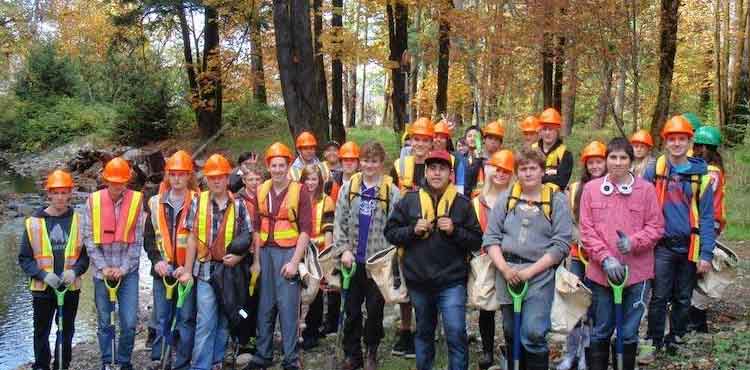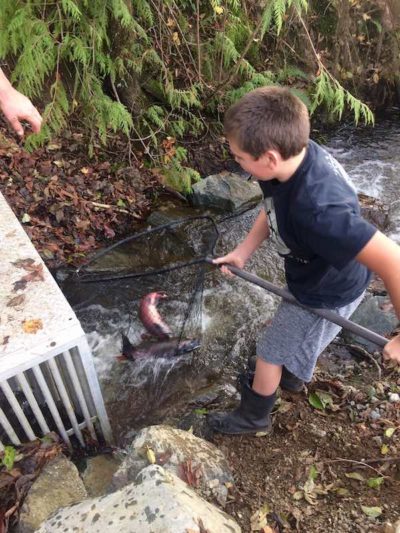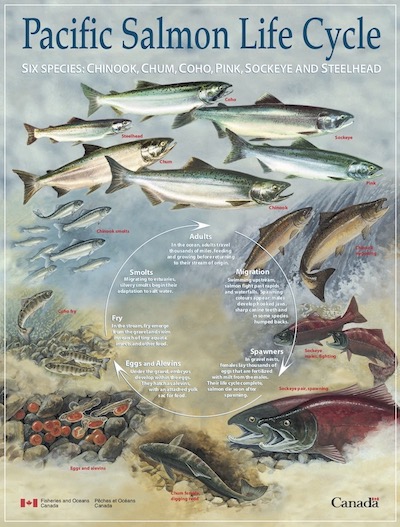

The West Coast Aquatic Stewardship Association hosts a number of community volunteer events including this one in Dry Creek near Port Alberni.
I grew up the only child of an avid sports fisherman, and visiting hatcheries and learning about salmon enhancement and habitat restoration was a big part of my education as a young angler.
Vancouver Island is home to approximately 37 hatcheries, seven of which are major federally operated facilities. In addition, there are also 45 First Nations and non-profit community-based groups working toward one common goal: helping to enhance salmon stocks as well as to protect, maintain, and restore their natural habitat.
In 2018 alone, almost 81 million salmon were released into local waters, with the average release being approximately 100 million fry and smolt annually. Events like the flooding in October of 2017 can affect the results; in the case of the 2018 season, it was also flooding in October that affected the ability to take brood stock.
From federally run hatcheries to people like Dan Shannon, a dairy farmer in Port Alberni who has built a micro-hatchery raising coho on the creeks running through his farm, there are passionate people and great efforts taking place on our island.

A Family Affair: Dan Shannon’s grandson helps to collect coho from their fish trap on their dairy farm in Port Alberni. Dan started the micro- hatchery in 1993 and now raises up to 50,000 coho fry annually.
Over the coming months, we will be highlighting these facilities and organizations as well as introducing you to some of the remarkable people whose passion translates to tireless efforts to protect our local salmon stocks. We will look at how salmon enhancement programs work and what you can do to get involved in your local community.
The goal of these articles is to provide you with the information you need to make that step that you have always thought about—to take your kids to a local hatchery for the afternoon or to finally make the call to your local stewardship association to see if they need volunteers (I can guarantee you the answer is YES).
Imagine how a small effort on the part of each of us could potentially create a cumulative impact on the success of our fisheries. Let’s start helping these people who have made such an impact on our lives as anglers.
As an introduction, let’s look at the salmon life cycle.
SEPs (salmon enhancement programs) follow the natural salmon lifecycle and add thousands to millions of fry, depending on the species, to supplement the systems in their surrounding areas.
Our waters are home to coho, Chinook, pink, chum, and sockeye salmon. All five of these species are anadromous, meaning that they begin their lives in fresh water, move to salt water, and return back to freshwater to spawn. SEPs are typically located alongside a river or stream for this reason.
Mature salmon instinctively return to the river or creek where they were born four or five years earlier; an instinct driven solely by their ability to sense pheromones. This is commonly referred to as “imprinting.” Salmon are able to decipher these chemicals from an amazing distance, and they are a guide to their place of birth. Most species will die a few days after spawning, except cutthroat and steelhead, which can spawn multiple times.
It is at this stage where the salmon enhancement programs acquire their brood stock for the following year. The mature fish that do not become brood will spawn naturally and die shortly afterward, becoming a great source of nutrients for the water system and its inhabiting plants and animals.
This is one of the reasons that habitat protection and restoration play such a crucial role in enhancement. These rivers and streams also house fertilized eggs, protected in the gravel bed of the system—another reason that habitat protection and restoration is so important to our stocks.
Consider the plight of a mature sockeye, making the long trek back to her original spawning ground where she was born and imprinted 4 years earlier. She succeeds in her long journey only to return to a muddy, washed-out creek; her journey for naught without having any viable gravel beds for her to deposit her eggs. That is why habitat restoration and protection and salmon enhancement are conjunctively important.
These articles will not delve into any politics or to lay any blame as to the state of our salmon stocks at present day. We are where we are, and the best way that we can help the resource that we so enjoy catching, releasing, and occasionally and responsibly harvesting, is to contribute. We all need to lead by example and work collectively toward the future of our sport.
I will say this: For thousands of years First Nations sustained their families by catching and preserving wild Pacific salmon, keeping only what they needed. When they had their ration, they ceased pulling from their precious resource. Salmon were and continue to be a key part of Native culture. Canneries began hitting our coast, cropping up on the Fraser River in the late 1800s. and the industrial world reaped the rewards of a largely unregulated fishery for a very long time.
It wasn’t until nearly 100 years later in 1977 when Fisheries and Oceans Canada began initiating a hatchery program to address the rapidly dwindling salmon stocks. They did so in partnership with the BC Ministry of Environment, which began to care for the steelhead and cutthroat stocks. It was at this time that local volunteer SEPs began working toward the same cause, volunteering their time in an effort to save this once abundant resource.

Conuma River Hatchery technician Jacob Knight proudly displays one of the coho brood stock selected in September. The coho returns to the Conuma River in 2018 were unlike anything seen in decades.
When I first started my research, I was rather intimidated by my lack of knowledge on the subject. As I began to make calls, I was immediately met with enthusiasm and encouragement from many experts in this field. I extend thanks for the tremendous support from all sectors of the fishing industry, from fellow sport fishermen to DFO staff, organization directors, and right down to the amazing pep talk from a family friend who is a lifelong commercial fisherman and avid conservationist. He still called me a “Low-Life Sporty” with an encouraging wink; but hey, Rome wasn’t built in a day!
There is one common agreement amongst these groups so prone to conflict: a deep-rooted respect for those working toward the cause and the value of salmon enhancement, and the fact that more help from all of us is imperative.
In the spirit of collaboration, if you know of anyone in your community who you feel should be highlighted for their exceptional efforts toward preserving our salmon, I would very much like to hear from you at allison (at) ifishmag.com.
Related Links
More educational resources available at http://www.pac.dfo-mpo.gc.ca/education/resources-ressources-eng.html
One Comment
Leave A Comment
Visit the Store
$34.99
$34.99
Featured Catch

Joel Unickow halibut (Photo: Rob Frawley Lucky Strike Sportfishing Tofino)









Excellent article by Allison once again it’s been great reading on many levels – keep up the great work!